ASUS TUF Z370-Pro Gaming Motherboard Review
Peter Donnell / 7 years ago
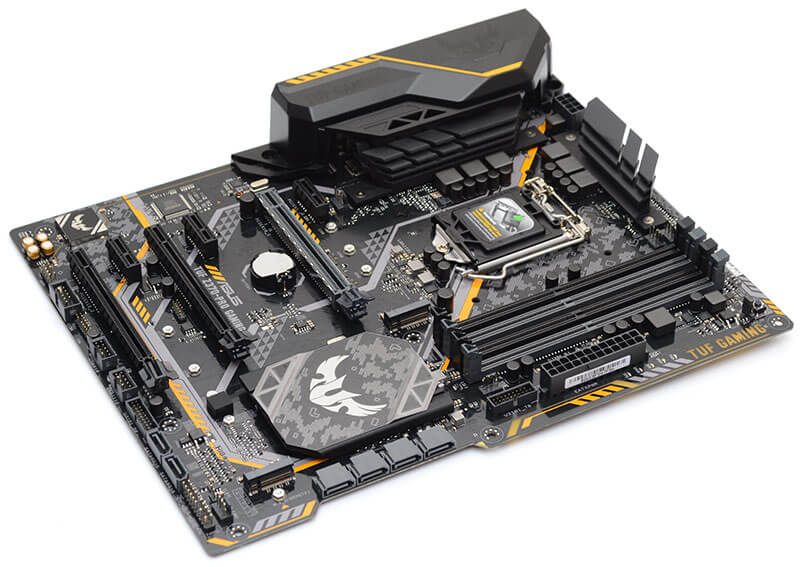
ASUS TUF Z370-Pro Gaming
Do you need a motherboard that’s a little more robust and unique? Then the ASUS TUF series is usually a safe choice. Their new Z370-Pro Gaming is on our test bench today, and it’s already only of the most unique looking Z370 motherboards we’ve seen in the office, or anywhere for that matter.
It comes equipped with TUF Protection and TUF Components, ensuring your system stays running in demanding tasks, 24/7. That’s good news for those who plan to overclock their hardware and run their system with demanding tasks extensively.

For your investment, you’ll get DTS Custom Audio, a nice assortment of voltage protection systems, and high-end components such as TUF Chokes, and MOSFETs. Add to that Xpert 4 fan control and in M.2 storage, and you’ve got a pretty complete package.
- ASUS OptiMem: Careful routing of traces and vias to preserve signal integrity for improved memory overclocking
- Exclusive DTS Custom audio: Delivers positional cues to stereo headphones, helping you to pinpoint enemies and action
- TUF Protection: SafeSlot, ESD Guards, DDR4 overvoltage protection, Digi+ VRM, and stainless-steel back I/O for long-term reliability
- TUF Components: TUF LANGuard, TUF Chokes, TUF Capacitors, and TUF MOSFETs for maximum durability
- Fan Xpert 4 Core: Ensures every fan achieves the best balance of cooling performance and acoustics
- Native M.2: Built-in interface for latest SSDs, delivering lightning-fast storage speeds of up to 32Gbps

What ASUS Had to Say
“TUF Gaming motherboards are built to survive and thrive on every battlefield. Infused with the military spirit of The Ultimate Force (TUF) and styled to strike fear into the hearts of every enemy, TUF Z370-Pro Gaming is the perfect foundation for your ATX battle rig: a solid, durable and camouflaged force that’s fit for today’s fights, and with the durability to handle multiple upgrades for the campaigns of tomorrow.” – ASUS
Motherboard Overview
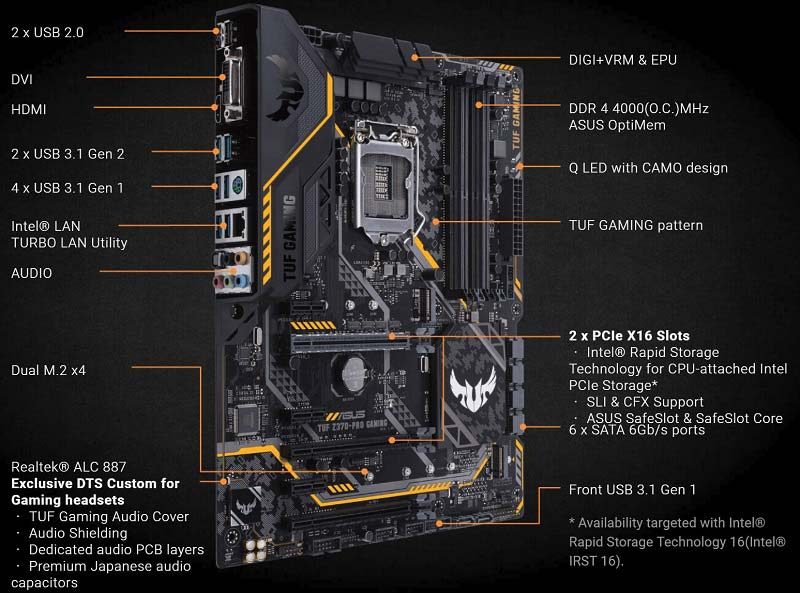
What’s in the Box
In the box, you’ll get the owners manual, a backplate, some SATA cables, a few screws, and an SLI bridge. That’s not a lot of stuff, but at least the board is packed with features to make up for it.
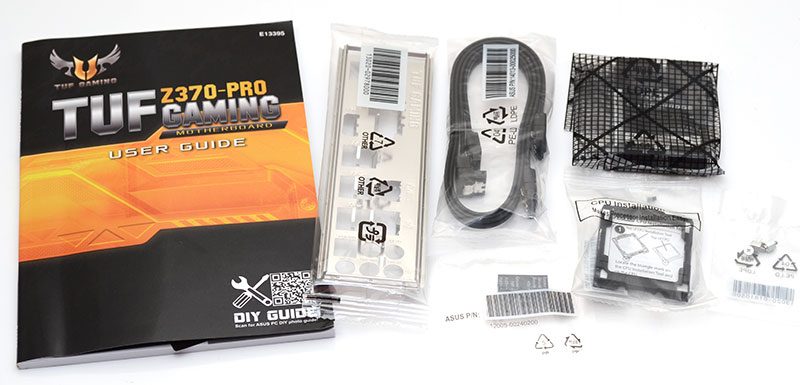
A Closer Look
Who cares about performance? Just look at that motherboard, it’s certainly a great looking bit of kit. OK, we really care about the performance too, but as much as looks are subjective, that’s a gorgeous and unique looking motherboard!

The new-ish socket is sitting in the middle here, offering up support for the new 8th generation Intel Core processors. Surrounding that you’ve got those lovely TUF components, such as the chokes and capacitors, which should allow for clean delivery of power to the CPU for more stable round-the-clock overclocking.
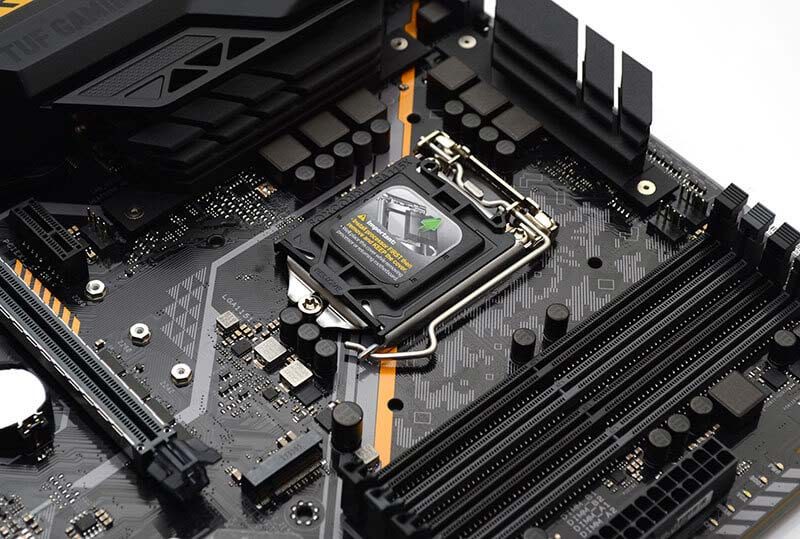
Another lovely feature is that huge rear I/O guard, which keeps things looking clean. It’s even designed to overhang and match up with the heat sink to keep things flowing nicely.

DDR4
Four DIMM slots, again with their own high-quality components to allow for better overclocking of your memory. Here you can also see that cool digital effect design on the PCB; it’s the little details that add up.
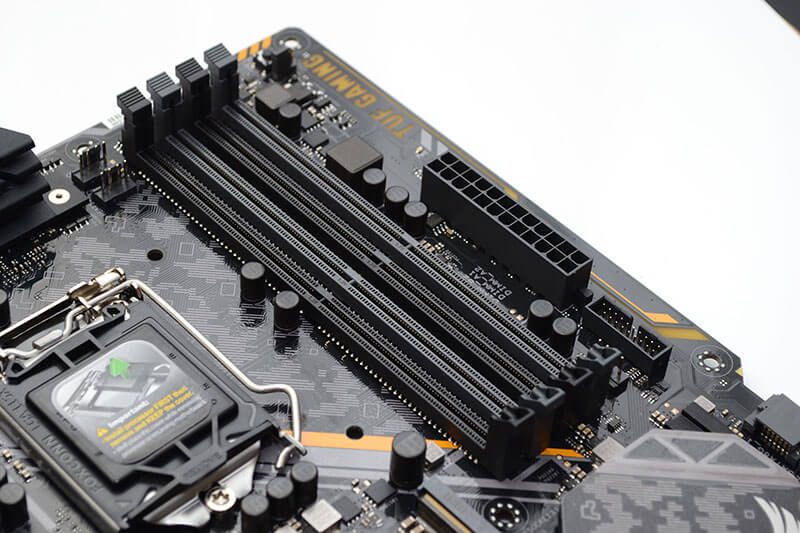
Connectivity
Down the right side of the motherboard, there are four SATA ports. There’s also a cool cut-away on the motherboard, it serves no purpose, but in my own words “it looks dope.”
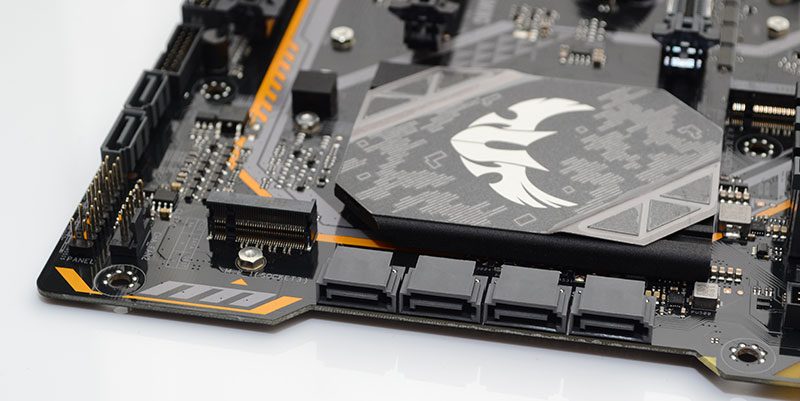
There are two more SATA ports down the bottom edge, as well as all your USB, front panel and a few fan headers. There’s also an M.2 connection here, with a second one between the PCIe slots.
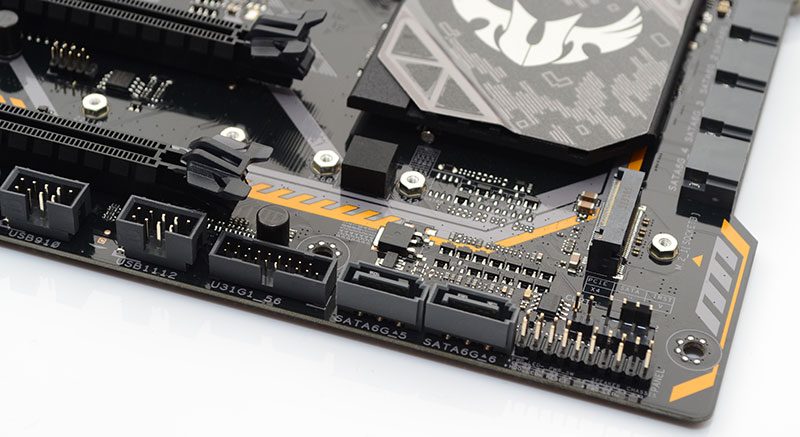
There are three full-size PCIe slots, and 3 shorter ones. The top full-size one is armoured, but I would have liked to see at least two of them done for those using more than one heavy graphics cards.
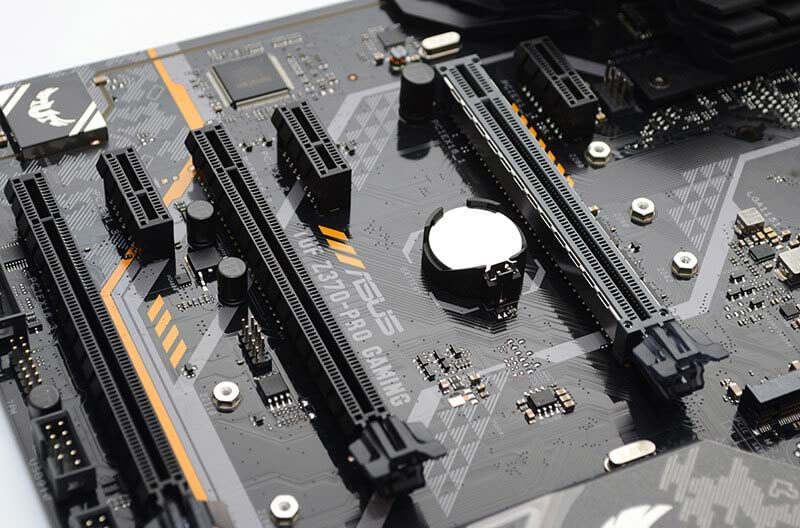
Finally, you’ll find a reasonably well equipped rear panel. There’s a selection of USB ports, PS2, HD Audio and optical. For displays, you’ll also find an HDMI port, as well as a DVI connector; sorry, no DisplayPort here.
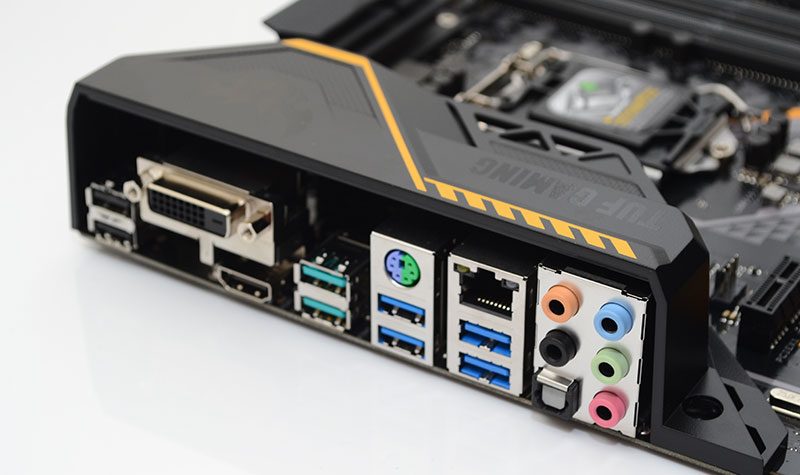
Testing and Methodology
Test Procedure
Here at eTeknix, we endeavour to disclose vital information regarding the benchmarking process so that readers can quantify the results and attempt to replicate them using their hardware. When it comes to motherboard reviews, the benchmarks are pretty self-explanatory although there are a few exceptions.
Rember that your choice of motherboard, the silicon lottery, and other factors can yield different numbers, and there’s always a margin for error when using the software. Therefore, your experience may vary. Each benchmark runs three times, and the average figure is taken to try to reduce the effect of hardware variation. Of course, any relevant details regarding the parameters will be listed below.
Test Systems
Z370
- Motherboard – Changes Per Review
- RAM – Crucial DDR4 2400MHz Dual-channel 16GB
- Intel Core i7-8700K
- CPU Cooler – Noctua D15S with dual fans
- Graphics Card – Nvidia GeForce GTX 1080 Ti
- Power Supply – BeQuiet Dark Power Pro 850 Watt
- Main Storage Drive – Toshiba OCZ VX500 500GB
- Chassis – Lian Li T80 Test Bench
- Operating System – Windows 10 Pro 64 Bit
X399
- Motherboard – Changes Per Review
- RAM – Crucial DDR4 2400MHz Quad-Channel 32GB
- CPU Cooler – Noctua D15S
- Graphics Card – Nvidia GeForce GTX 1080 Ti
- Power Supply – BeQuiet Dark Power Pro 850 Watt
- Main Storage Drive – Toshiba OCZ VX500 500GB
- Chassis – Lian Li T80 Test Bench
- Operating System – Windows 10 Pro 64 Bit
X299
- Motherboard – Changes Per Review
- RAM – Crucial DDR4 2400MHz Quad-Channel 32GB
- CPU Cooler – Noctua D15S with dual fans
- Graphics Card – Nvidia GeForce GTX 1080 Ti
- Power Supply – BeQuiet Dark Power Pro 850 Watt
- Main Storage Drive – Toshiba OCZ VX500 500GB
- Chassis – Lian Li T80 Test Bench
- Operating System – Windows 10 Pro 64 Bit
AM4 Ryzen R3, R5 and R7
- Motherboard – Changes Per Review
- RAM – GeIL DDR4 2977MHz Dual Channel 16GB
- CPU Cooler – Noctua D15S with dual fans
- Graphics Card – Nvidia GeForce GTX 1080 Ti
- Power Supply – BeQuiet Dark Power Pro 850 Watt
- Main Storage Drive – Toshiba OCZ VX500 500GB
- Chassis – Lian Li T80 Test Bench
- Operating System – Windows 10 Pro 64 Bit
Z270
- Motherboard – Changes Per Review
- RAM – Crucial 16GB (2 x 8GB) 2666 MHz
- CPU Cooler – Noctua D15S
- Graphics Card – Nvidia GeForce GTX 1080 Ti
- Power Supply – BeQuiet Dark Power Pro 850 Watt
- Main Storage Drive – Toshiba OCZ VX500 500GB
- Chassis – Lian Li T80 Test Bench
- Operating System – Windows 10 Pro 64 Bit
X99
- Motherboard – Changes Per Review
- RAM – Crucial 16GB (2 x 8GB) 2666 MHz
- CPU Cooler – Noctua D15S with dual fans
- Graphics Card – Nvidia GeForce GTX 1080 Ti
- Power Supply – BeQuiet Dark Power Pro 850 Watt
- Main Storage Drive – Toshiba OCZ VX500 500GB
- Chassis – Lian Li T80 Open Air Test Bench
- Operating System – Windows 10 64-bit
Games Used
All games are tested on a 60 Hz display with V-Sync off for all tests. Previously we would use “extreme” presets, but these have now been adjusted to “Medium” or equivalent to better test the capabilities of the CPU, not the GPU.
- Rise of the Tomb Raider (Steam)
- DX12 Medium Preset
- Pure Hair Off
- Deus Ex (Steam)
- DX12 Medium Preset
- Ghost Recon: Wildlands (Uplay)
- Medium Preset
- Turf Effects Off
- Far Cry Primal (Uplay)
- Normal Preset
Software Used
- 3DMark Fire Strike (download)
- FireStrike (1080p) Benchmark
- Unigine Superposition (download)
- 1080p Extreme Benchmark
- PCMark 10 Professional (download)
- Express Benchmark
- WPrime (download)
- 32M and 1024M
- Power usage recorded at 1024M 50% complete, thermals recorded at 75%
- CineBench R15 (download)
- CPU Multi
- CPU Single
- Handbrake (download)
- Custom MP4 to MKV 4K conversion (details below)
- AIDA64 Engineer (download)
- CPU-Z (download)
- HWMonitor (download)
Handbrake
To stress processors to their absolute limit and accurately judge their performance in video editing workloads, we transcode a 7.7GB compilation of gaming footage; this particular file is freely available from here. The captured footage is 22 minutes and 12 seconds long, it has a bit rate of 50.1 Mbps and it uses the Advanced Video Codec. Additionally, the video runs at a constant 30 frames-per-second and opts for a 3820 x 2140 (4K) resolution. Once loaded into Handbrake, we then transcode the 4K MP4 to an MKV file using the “normal” profile.
Other Notes
A rest period of 2-5 minutes is observed between each piece of software allowing the system to return to its idle power usage and temperatures. Background services like Windows Update are checked to not be running during the testing period by setting WiFi to Metered Connection.
Thanks
Thank you to Noctua, Crucial, ASUS, Gigabyte, Lian-Li, be quiet!, OCZ, for providing the hardware that helps makes these tests possible!
Synthetic Benchmarks
3DMark Firestrike
Boom, the TUF Pro comes out swinging, setting our fastest ever score for stock clocks. That’s a great place to start for any motherboard. It dropped to second place once overclocked, but only just, and that’s still a sweet score.
Stock
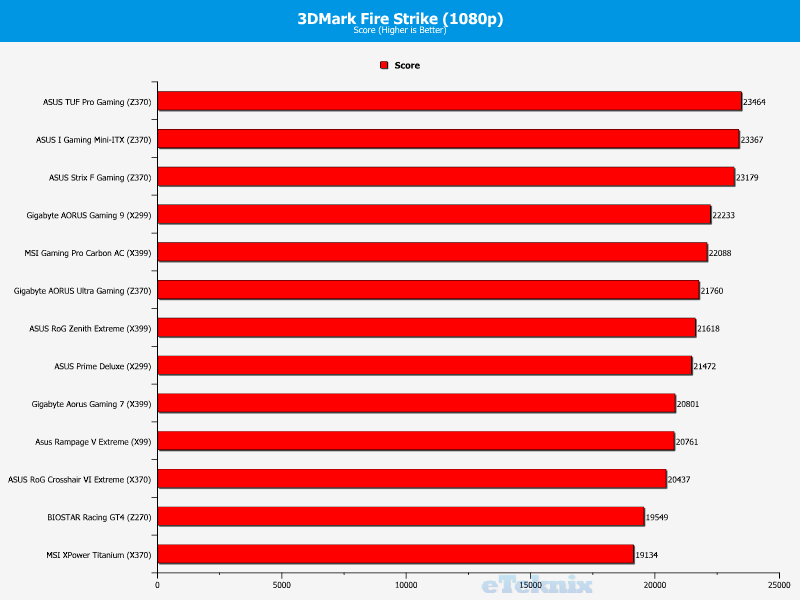
Overclocked
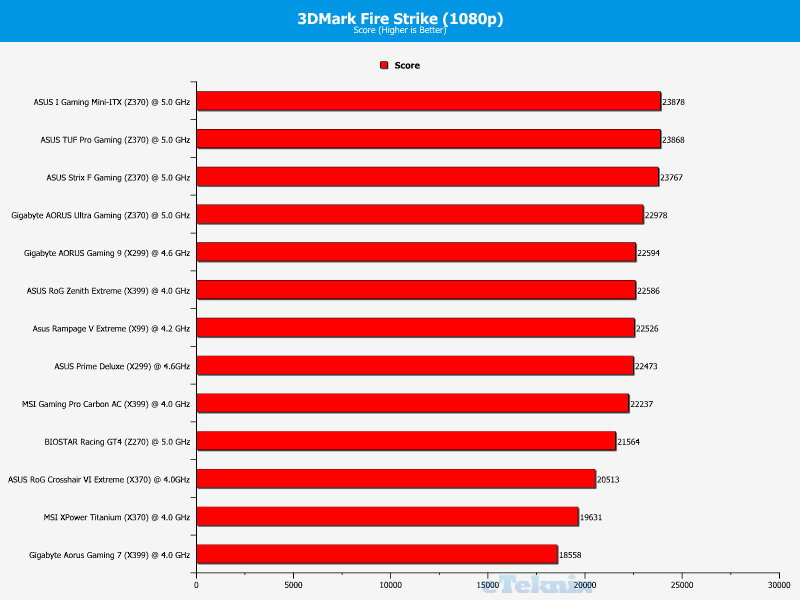
Unigine Superposition 1080p Extreme
Switching to a more GPU bound task to test the PCIe throughput, the TUF scored strongly, showing a clean score for Unigine on our GTX 1080 Ti. Overclocking gave a small boost too, which is always nice to see.
Stock
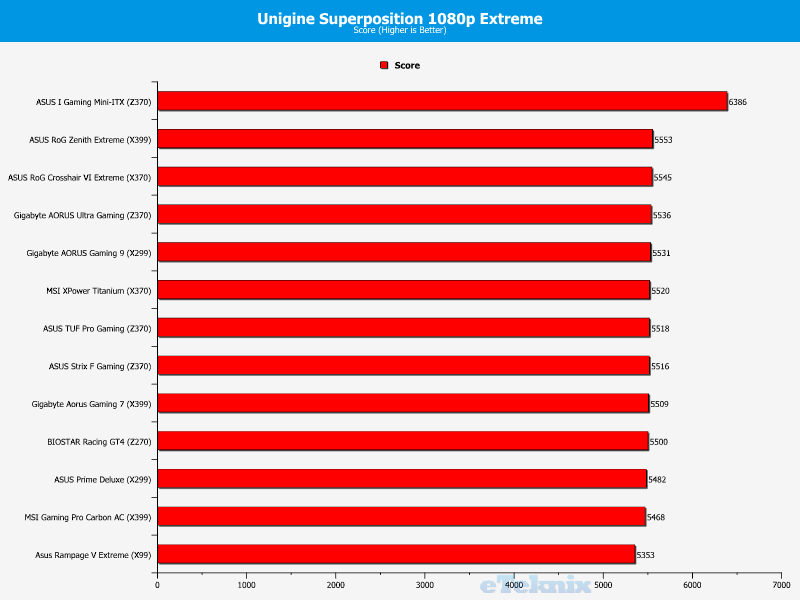
Overclocked
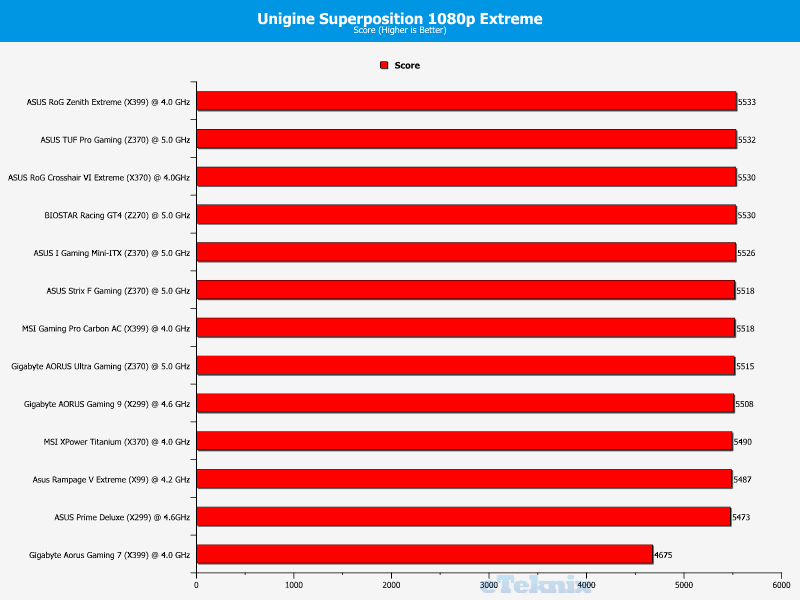
PCMark 10 Express
Another fantastic score for the TUF, setting our second highest PCMark 10 Express score and beating out a few other new Z370 motherboards in the process. One overclocked, the score saw a nice bump up to 6587 too. Overall, the i7-8700K and the TUF motherboard make a fantastic team.
Stock
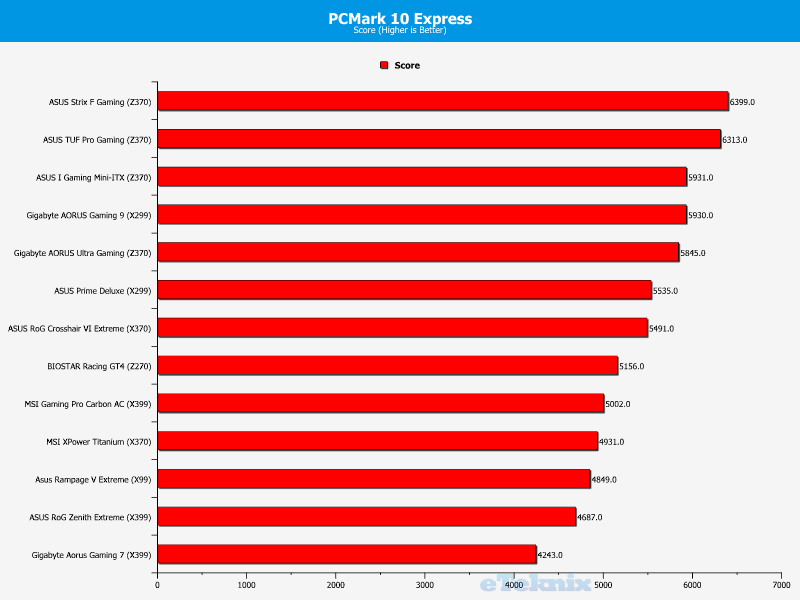
Overclocked
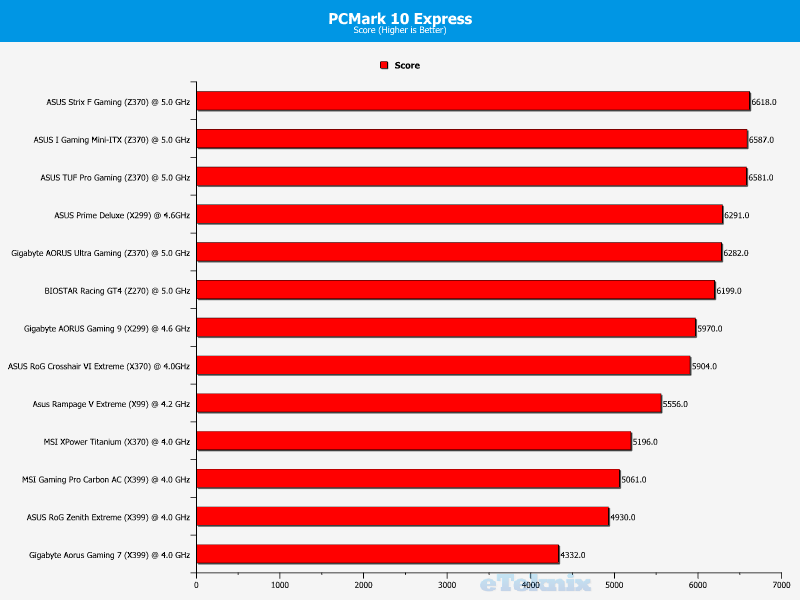
WPrime 32M and 1024M
The WPrime score is competitive too, not the fastest, but about where it should be for the chosen CPU and this chipset. There’s a nice boost from overclocking, but the other ASUS boards still have the lead here, at least for Z370.
Stock
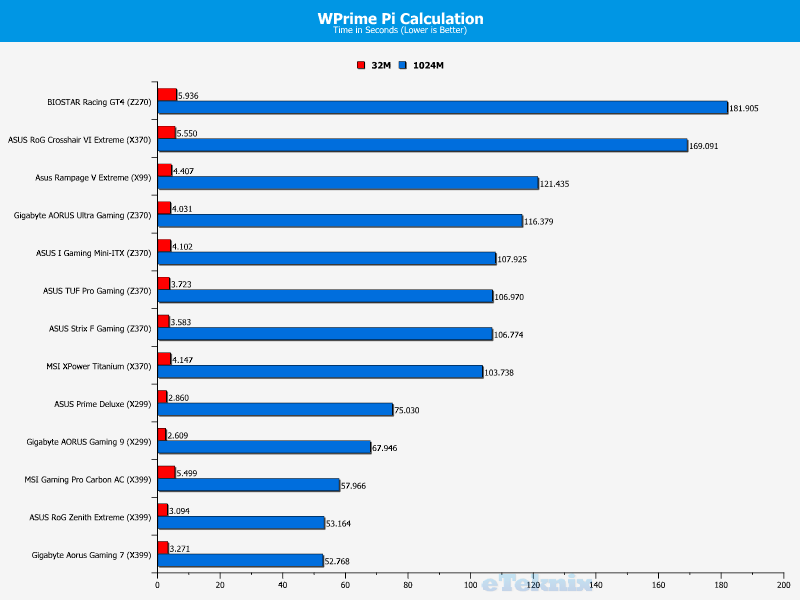
Overclocked
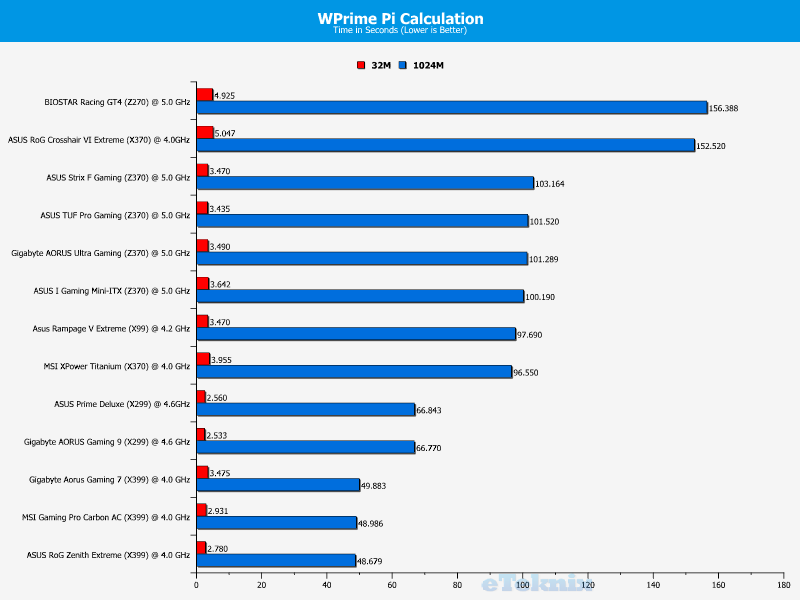
Cinebench R15
Again, the motherboard is second place for the Z370 hardware at stock clocks. Of course, it’s not worth comparing those crazy X399 and X299 motherboards for Cinebench, but when it comes to consumer boards, the TUF is one of the fastest we’ve ever tested. What’s worth pointing out though, is that while Multi-Core test was fast, the TUF set our highest ever Single-Core performance score at 208. Overclocking, it was the fastest Z370 motherboard around, giving us more reasons to praise this board.
Stock
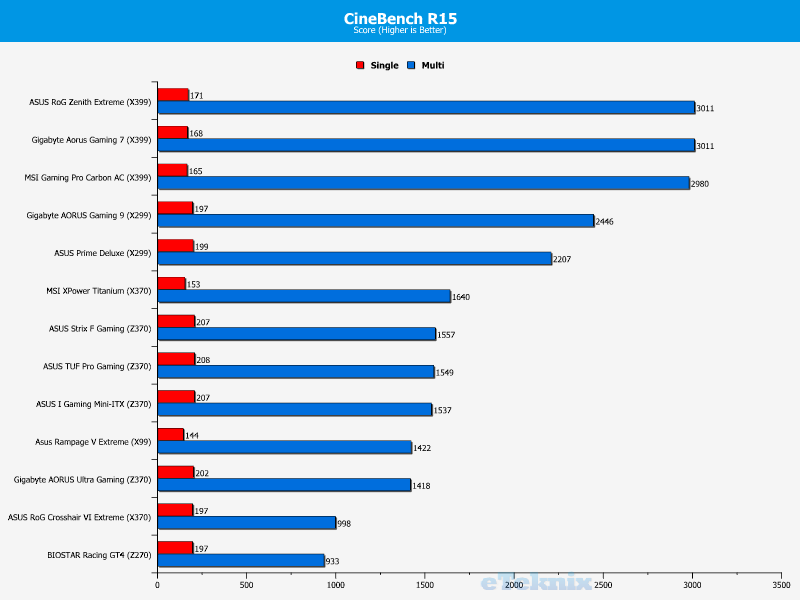
Overclocked
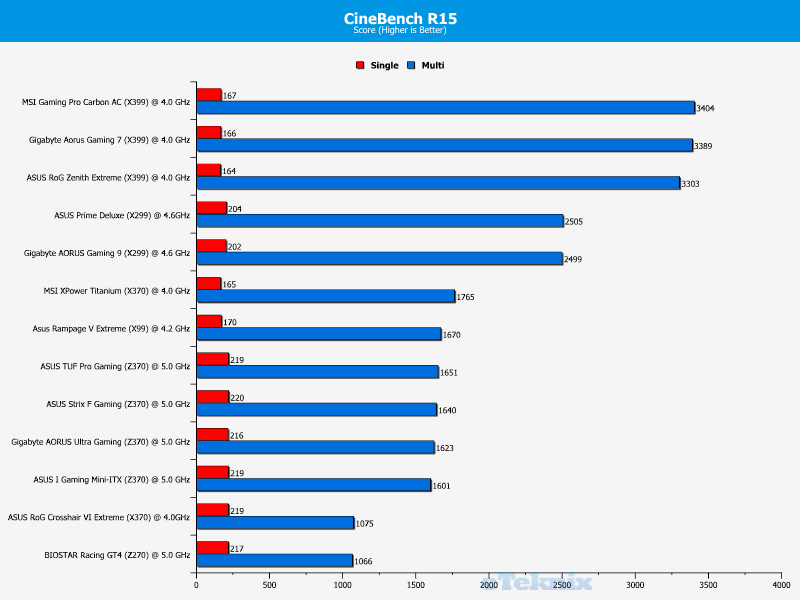
Handbrake MP4 to MKV Conversion 4K
The handbrake score was great too, right where we expected it to be and blazing fast for a consumer grade motherboard/CPU combination.
Stock
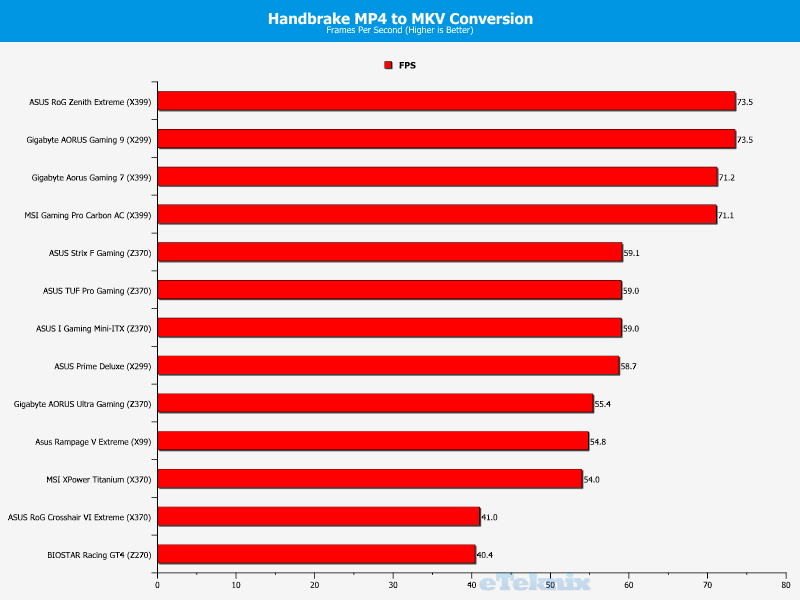
Overclocked
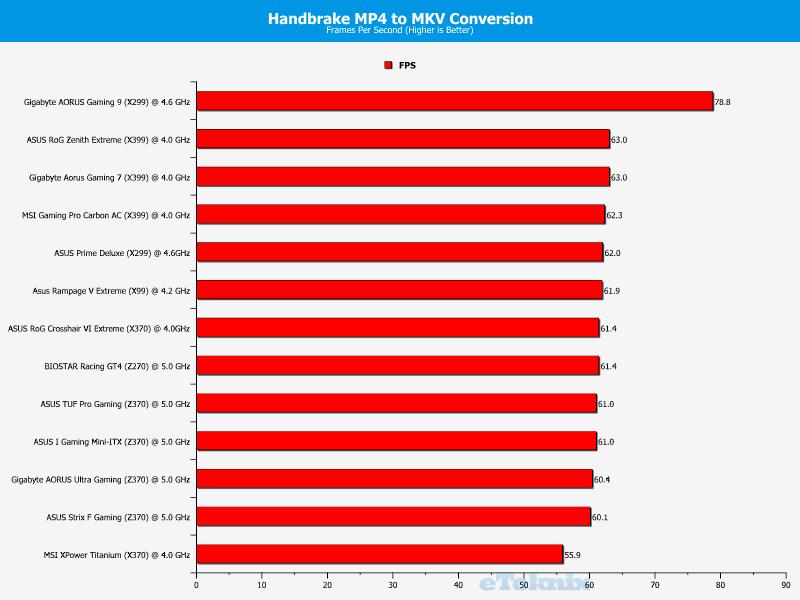
AIDA 64 Memory Bandwidth and Latency
The memory performance was spectacular too, giving us some of our most consistent results to date, and beating out a few of the other Z370 motherboards, as well as delivering a low latency that’s sure to give you great performance. In fact, it did give us great performance.


Gaming Performance
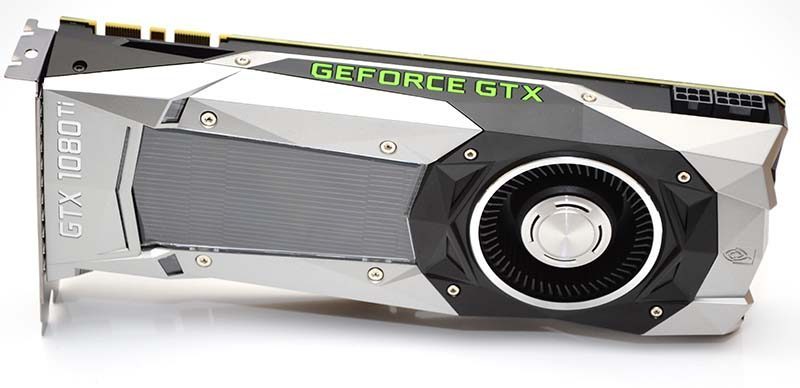
For gaming, the TUF is certainly putting on a strong show. It set some of our fastest ever scores along with the other ASUS motherboards from the Z370 range. Any doubts about Coffee Lake not being a great gaming platform as a distant memory at this point. The Tomb Raider score was a little lower than expected, but a great score overall.
Deus Ex: Mankind Divided
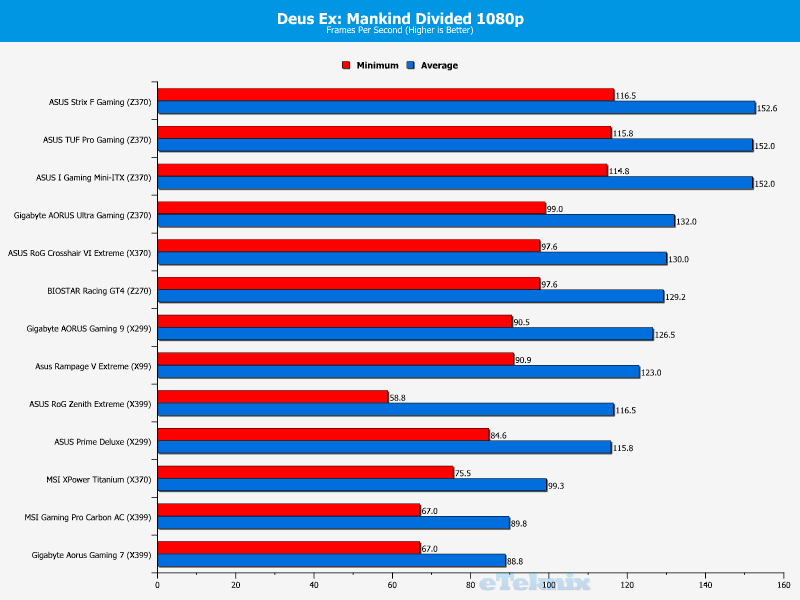
Rise of the Tomb Raider
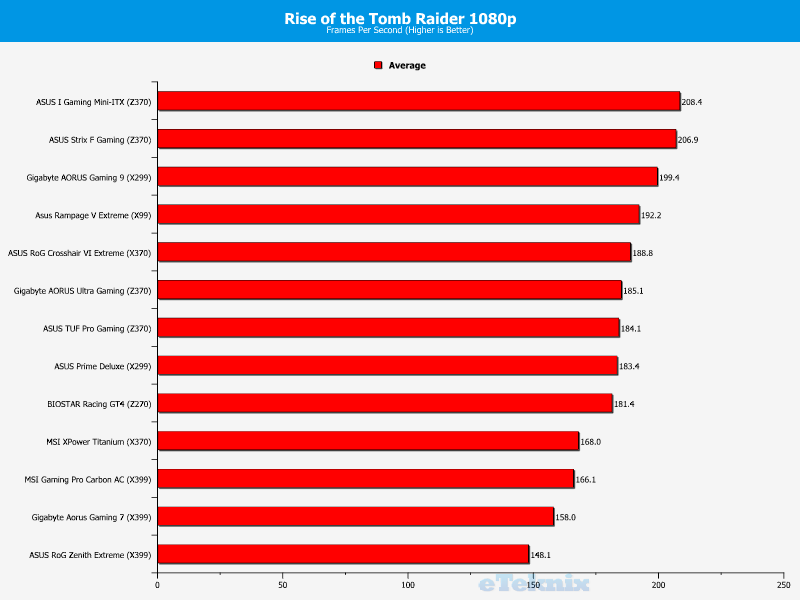
Ghost Recon: Wildlands
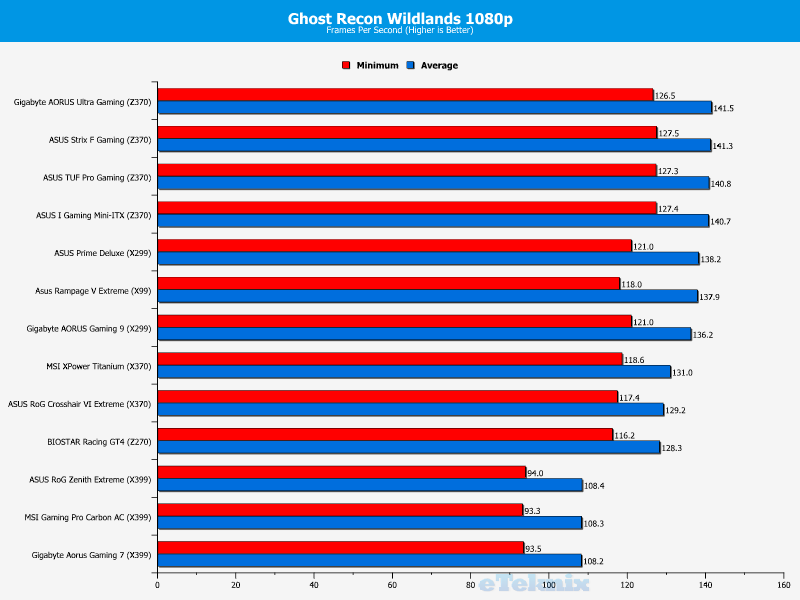
Far Cry Primal
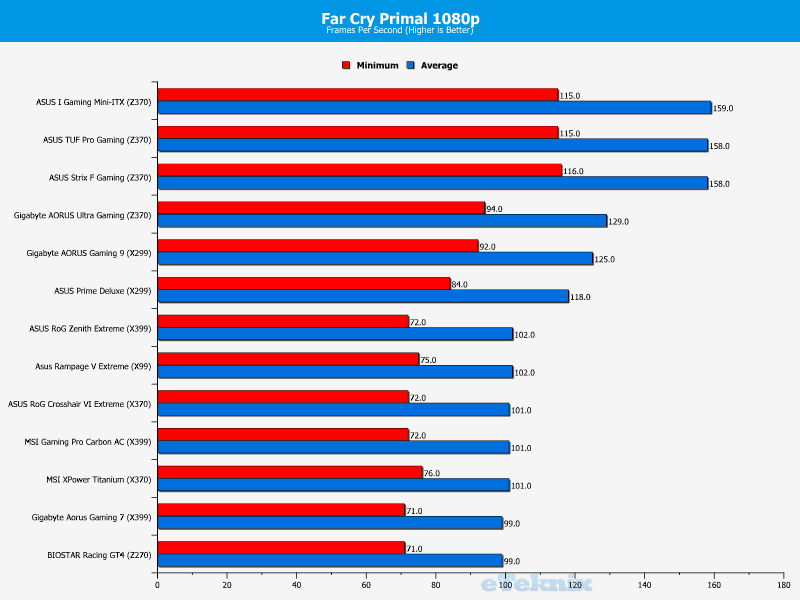
Power Consumption and Temperatures
Power Consumption
The Power consumption is a little higher than most, especially at idle, where it’s quite hungry for electricity. This could be down to the more robust voltage regulation hardware on the board, giving it added system stability. Once overclocked, it’s the most power hungry Z370 board we’ve tested, but not by a big market.
Stock
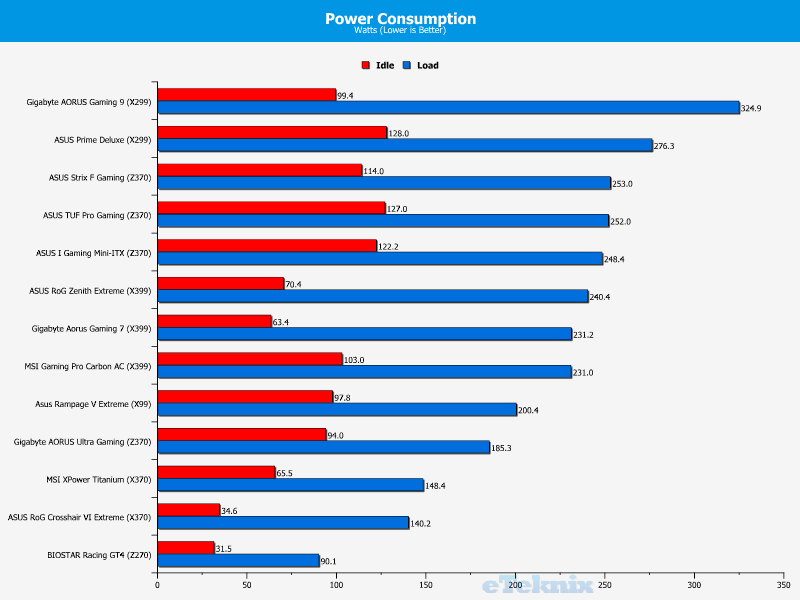
Overclocked
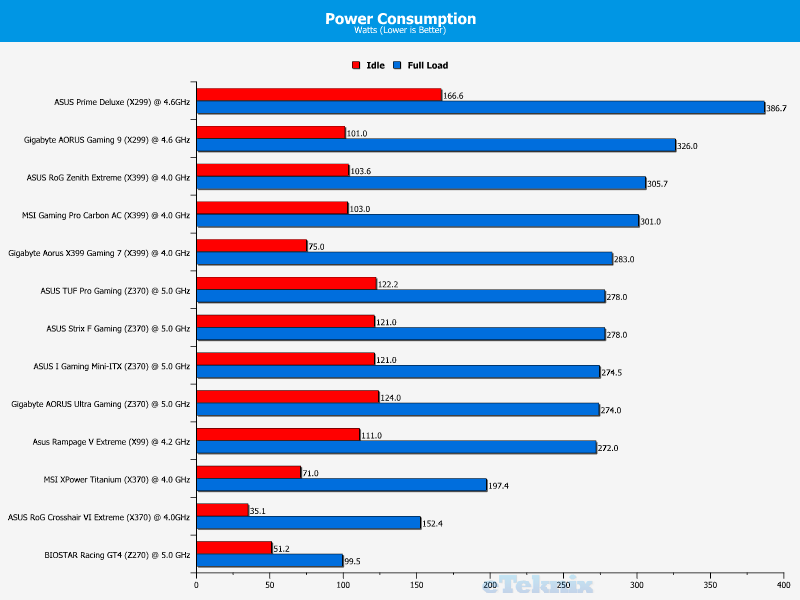
Final Thoughts
Pricing
The ASUS TUF Z370-Pro Gaming Motherboard is launching today with an SRP of just £149.99. I think that’s pretty reasonable for any high-end motherboard, at least before you dive into the crazy enthusiast-grade stuff. It’s certainly good value given the performance figures we’ve seen today too. Plus, it’s cheaper than the £187.99 Z370-F Gaming.
Overview
The new TUF motherboard from ASUS is one of their best ones yet. It doesn’t have bonkers features like you might find on something like the Maximum series, but it has more than enough for most users. If you’re building a high-end system for day-to-day workloads, as well as high-end gaming, it’s perfect for the job.
Design
This is one of the best-looking motherboards on the market. Is it pretty? Not really, it’s quite aggressive in terms of design if anything, but I like that. The black and yellow/orange colours really make the board pop in terms of visuals, and it’s sure to look great in virtually any system build.
Hardware
Of course, the aesthetics aren’t always that important. However, as good as it looks, that high-end hardware is every bit functional too. The TUF hardware is built for reliability, durability and stability. If you overclock your hardware and run your system hard for extended periods, even 24/7, TUF hardware is the way to go. It’s built to a higher standard, and comes with improved voltage protection systems to ensure your hardware stays in the best of health should the worst happen.
Performance
While it may not be the most expensive motherboard of the Z370 range, far from it in fact, it’s certainly one of the best performing. When it comes to work tasks, it’s a power house, and when it comes to gaming, it really blazes an impressive trail that’s hard to ignore. Add to that the option to add M.2 storage, Optane, fast DDR4 memory, multiple graphics cards, and more. Overall, this is by far one of the best value and best performing Z370 motherboards you can buy.
Pros
- Fantastic gaming performance
- Great for day-to-day workloads
- TUF hardware
- Robust hardware protection features
- Unique aesthetics
- Competitive price (relative to performance)
- Optane and M.2 storage
- Good connectivity
- Rear I/O guard
Cons
- None
“As one of the fastest, best performing, and most unique looking motherboards in the Z370 range, the TUF Z370-Pro Gaming is a great choice for any system builder. Even better, it’s also one of the best priced motherboards too!”

ASUS TUF Z370-Pro Gaming Motherboard Review



















